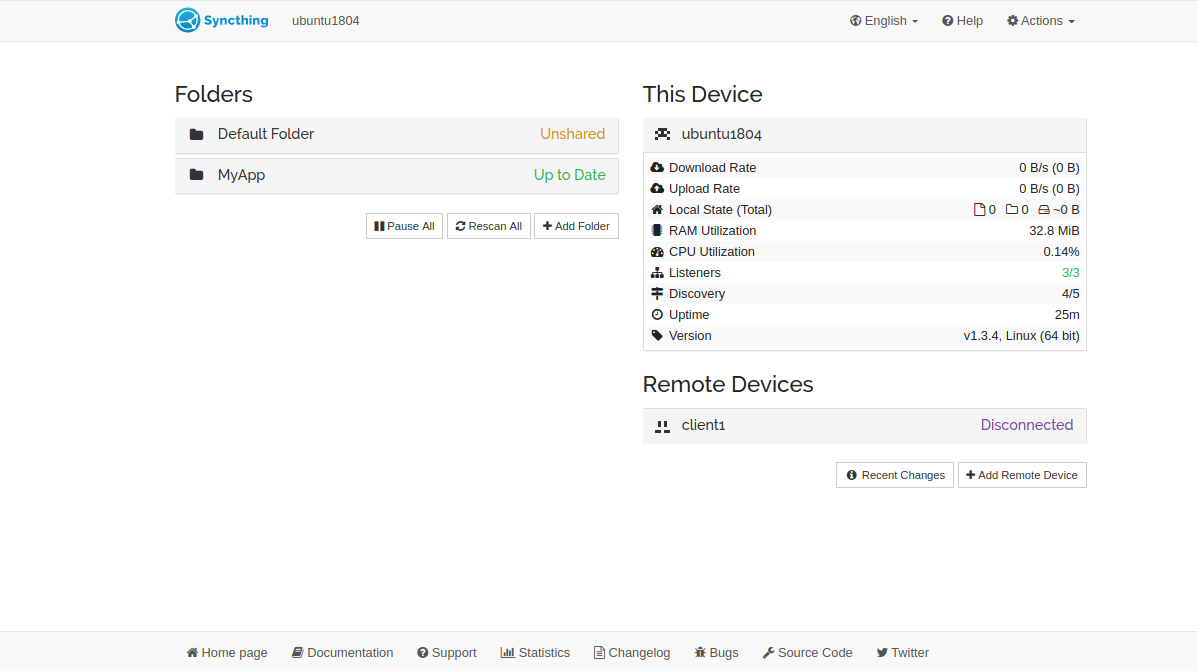

- #Syncthing ubuntu install how to#
- #Syncthing ubuntu install install#
- #Syncthing ubuntu install update#
- #Syncthing ubuntu install code#
- #Syncthing ubuntu install download#
And paste the ID into the Device ID field back on the Syncthing A node.Ĭomplicated at first, but once you get the hang of Syncthing, it'll be easier.Ĭlick Save on that window and it'll add Syncthing B as a new device.
#Syncthing ubuntu install code#
Copy this ID or use the QR code to scan the ID. Here you will see the Syncthing B Syncthing ID. If you don't see the ID, simply navigate to your other Syncthing node (let's call it Syncthing B), select Actions > Show ID from the top right menu. Syncthing automatically polls your local network looking for existing nodes, depending on how your other nodes are set up, you may or may not see this. You may notice that there is an existing ID which is available to click. To add a new Device, select the Add Remote Device button, which will open up a new popup window. Now with all that running, you should be able to access the Syncthing GUI by navigating to: Once entering your ip-address or hostname, you should be presented with something that looks like this Adding Devices (nodes)
#Syncthing ubuntu install install#
Simply follow the above steps again on another machine, or jump to the bottom of this page quickly and install Syncthing on Windows or Android

sudo systemctl restart Second Node For Syncthing to work, you need to set up another Syncthing node. Save and close config.xml and then restart Syncthing by running the following command.
#Syncthing ubuntu install update#
Under the address attribute, you need to update the ip address.Ġ.0.0.0 will allow all machines on your local network to be able to access the Syncthing GUI. Within config.xml there is a section that looks like this. Open this with a text editor, something like Vim or Nano. When you ran the Syncthing command above, a syncthing folder was created under your /home/username/.config folder. The way we can change this to allow local access from another machine is to change the serve address. So at the moment there is no way to access the Syncthing GUI to configure your folders and nodes. Problem is, Ubuntu Server is usually headless. So this will start Syncthing on your Ubuntu Server. This will allow start-up on boot and continuous execution in the background of your server. The next thing you want to do is enable Syncthing as a system service. Next, update your local repository with the new Syncthing repository sudo apt-get update sudo apt-get install curl apt-transport-httpsĮcho "deb syncthing stable" | sudo tee /etc/apt//syncthing.list
#Syncthing ubuntu install download#
My 'central' server is running Ubuntu Server, so the following instructions are tailored for Debian distros.įirstly, you need to install the correct package locations in order to download Syncthing correctly. You could use a cheap Raspberry PI to set up your 'central' server.
#Syncthing ubuntu install how to#
I'm going to show you how to set up Syncthing in the context of my setup. Setting up Syncthing Require some assistance? Our experts can help get you set up! So in my case, I am sharing my blog with my personal laptop and my 'central' server, just to backup my data. You can then specify which nodes, the folder you created, to be shared with.

I'm currently writing this blog post on my personal laptop, which is syncing to my blog server as I type (well, hit save). With the multiple nodes set up, I can choose folders that can sync. I have spoken about Syncthing on Android in my My Self Hosted Note Syncing Journey Once Switching to Iphone post. I then have multiple other nodes, such as: my main laptop, a work machine and even my Android phone. I quoted 'central' as the loft server is just a node, there's nothing special about it other than having a backup cron job running on it. I have a 'central' Syncthing server which lives in my loft. Nodes don't just have to be on your local network, you can sync between nodes over the internet. Syncthing will encrypt all data when it is being transported to your other nodes. Syncthing enables the user to set up multiple 'nodes' which can communicate with eachother.Ī node can be, your personal computer, a work machine, a machine in another location or even a central server. By putting the user in control of their own data.

Syncthing aims to replace services such as: Dropbox, Google Drive and OneDrive. Syncthing is a P2P (peer to peer) network that allows you to keep your files synchronised.


 0 kommentar(er)
0 kommentar(er)
